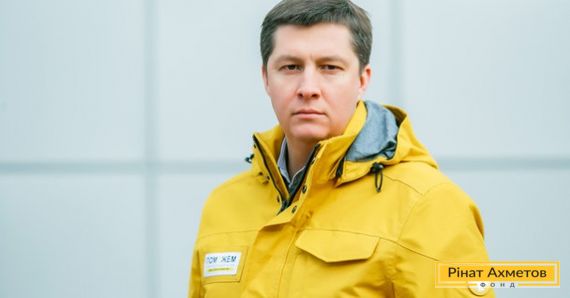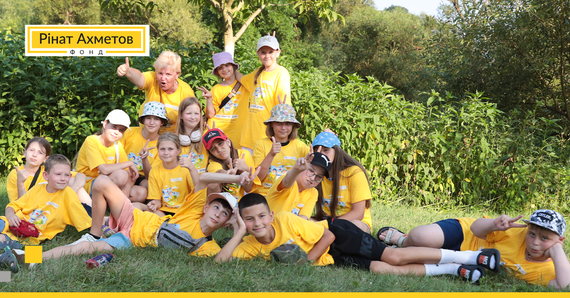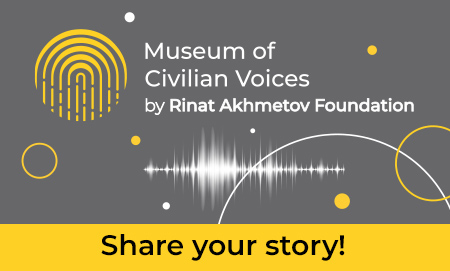Aleksandr Vishnyakov: ‘The Humanitarian Center work does not stop even for a second’

Aleksandr Vishnyakov, director of the Rinat Akhmetov Humanitarian Center, told UA Today how the volunteers of the Humanitarian Center saved and continue to save the most disadvantaged groups of society in Eastern Ukraine despite the obstacles and risks - inspections, impassability, shelling.
– How did you come up with the idea for establishing the Humanitarian Center? Was there a phone call from Rinat Akhmetov with the initiative to help or was there the idea of the team?
– In 2014, as soon as it became clear that the real war went into our house, Rinat Akhmetov made a decision to establish the Humanitarian Center in order to save civilians by combining the efforts of the Foundation for Development of Ukraine, Football Club Shakhtar and business assets of SCM Group. We realized that behind this decision lies compassion of Rinat Akhmetov, his great desire to help fellows affected by the war. When we watched his involvement in the work being available by phone during 24 hours, even hourly, with the Center, helping to solve seemingly unsolvable problems, we were eager to do the impossible as well!
Our hotline melted from dozens of calls received from Donbass residents - they were crying, asking for help as their villages were shelled, the shops did not work, there was no water. People asked to bring food products, even from those districts where there was no shelling. These calls confirmed that the situation was critical. It was summer. A great many of people hoped that the war is a temporal event and went away on holiday with their families. In August 2014, Donetsk resembled the early Sunday morning. There were few people in the street; life in Kievsky Avenue seemed to have stopped. There were no dogs or cats. We came to Kievsky and Kuybyshevsky districts, in the areas of the Zhovtnevyi Rudnyk coal mine and airport, where the people mostly live in the private sector, and saw that people organized themselves into groups trying to survive. If someone could bring something, he brought this for everyone. I remember our first meeting with the residents of Vzlyotnaya Street. To the strains of the shots, we agreed that the next day we would provide aid and asked to find out how many people live in houses to load our cars with food products which should be sufficient for everyone.
– What was the unifying factor for the team that was one of the originators of the Humanitarian Center?
– Other people’s pain! As there are no other people's children, thus, for those people who joined our team, there was no other people's pain. Our country and our home in which we grew up and in which, by the way, stubborn and rebellious generation grew up united us as well.
– How priorities have changed for three years? What was the primary focus in the work?
– Since the first days of our activities, we have paid special attention to the quality of provided assistance, observance of the terms of supply, storage, delivery and temperature conditions. The assistance cannot be of poor quality. This is the first rule. Then, we took care to ensure that the assistance is rendered sufficiently to support those who extremely need it. The third rule of our work: we did not just issue food packages, we tried to understand what is happening in a certain district, what needs people have, what actions must be taken to make a balanced food package in terms of energy values, fats, proteins and carbohydrates. We took the international humanitarian mission standards for reference. We could not fail at any stage, constantly analyzed and predicted the situation. All this is called a ‘systematic approach’. During the second year of our work, it was important for us to keep up with the changing landscape of events. When a firing point was changed, when a new ‘grey zone’ appeared, we responded faster to changes in the format and extent of the assistance. But at all times people who need support were of our great concern and focus.
– What were the principles of cooperation in the program ‘Targeted Aid’?
– Since the first days, ‘Targeted Aid’ has been dedicated to help wounded people and children. The pharmaceutical support, prosthetics and rehabilitation projects were functioned and now continue functioning. Since the beginning of the armed conflict, state support programs have not been functioning in the entire territory, so the project ‘Medicines for Children’ of the Humanitarian Center appeared. Within the framework of this project, parents of the children under the age of 18 received and are receiving packages of drugs that allow children suffering asthma, epilepsy, diabetes to prevent disability and, at least, to maintain their social capacity. There was one more serious problem - in the conflict zone, children could not have a rest and improve their health in summer. The response to this problem was the launch of the project ‘Peaceful Summer for Donbass Children’ in 2015, which we continue to implement now. Children have the opportunity to leave the war zone, have a rest in the camp and communicate with their age-mates.
– What were the obstacles the Humanitarian Center faced? How did you overcome the distrust and fear of people who received aid?
– We faced a lot of obstacles at different levels of our work. But people forgot their fears at a time when they got a food package and realized that nothing needed to do in return. Quite the contrary, the volunteers asked to take the package and promised to bring more. We had such an approach: to give a food package into hands and provide a card for repeat receipt. The card played a very important role! People understood that they have products to feed their families now, and they knew that the volunteers would bring more and they would be provided with food products. Over time, it became clear that the conflict was dragging out. But even with the introduction of the access control, the activities of the Humanitarian Center did not stop even for a second. When all the cargoes that were transported through the contact line had to be granted the status of humanitarian aid, we were the first who had passed through all stages of the documents review and approval. If the international humanitarian organizations had diplomatic and international mandates, we were an exception. The Rinat Akhmetov Humanitarian Center is the only humanitarian mission in Ukraine that has been created inside the country. We passed through all the approval stages, received recognition and necessary documents. I remember that we needed to draft about 25-30 types of documents just for one truck of the Humanitarian Center! And the number of semi-trailer trucks in the truck convoy reached 50-70 ... We were often stopped at different stages of work, inspected at warehouses in Dnepr and on the contact line. We passed inspections at the checkpoints, but we had all the permits of the fiscal services and other departments.
– What are the future plans of the Rinat Akhmetov Humanitarian Center?
– We continue to work in the ‘grey zone’ and deliver humanitarian aid to the most disadvantaged groups of society. At the moment, the Humanitarian Center provides support for more than 90% of settlements along the entire firing line. There are cities and villages where there are no roads: they have not been constructed before the war, and even more so during the war. But we are not afraid of impassability. We still observe both the personal safety rules for volunteers and the safety rules for cargoes. We continue to follow all the documented procedures of humanitarian assistance provision. The main focus of providing targeted aid now is children and it is highly unlikely that this focus will change in the near future. It is very unfortunate that our base of wounded children is growing. Wounds are not sore throat: you can restore your arm, you can make a prosthetic appliance for any part of your body, but this does not always restore the organ function. A child needs to attend a rehabilitation course in order to be capable or socially active. Someone needs one or two courses, and another one needs three or four more. We do realize that the need for this will be always great. The project ‘Healthy Heart’ is a bright example of this. A unique approach to the treatment of pediatric cardiac pathologies has been implemented. The children have been undergone abdominal operations and occluders have been installed using endovascular technique with minimal losses to the child’s health.
Any way, we always try to understand the real needs of people. For this purpose, we have a hotline, other channels through which we constantly maintain communication with those who need our support. We do understand that such communication is the most important component of major systematic efforts aimed at supporting people. Thanks to those efforts, we have managed to save more than a million of human lives for three years.



